
When considering a tactical bag, you may at first find yourself overwhelmed by the sheer amount of choice available.
It can feel like there are thousands, and all of them promise to be the best on the market, more than capable of keeping your everyday carry (EDC) gear safe and sound.
But… which one actually is?
In the world of military gear, which EDC is very much inspired by, everything is designed to be as rugged and durable as possible. Those bags are literally made to take on the battlefield!
Today we present a guide to choosing the right kit bag for you, providing plenty of considerations to make before you hit Add To Cart.
From ideal materials to the number of pockets and overall aesthetic you should be looking at, we’re covering all of the bases – this is the only article you’ll need to open.
Without wasting too much time giving context – let’s get right into it.
Features To Consider When Choosing A Tactical Bag:
Materials
Perhaps the most important factor of all, the material a bag is made of is fundamental in making your choice. It needs to be water, dirt and dust resistant, heat-resistant if possible, and able to withstand some serious rough and tumble.
Aiming for the strongest possible nylon, of at least 500 Dernier if not more, is only going to work in your favour. Easily able to withstand the elements, lightweight and sturdier than a drill sergeant, it’s very unlikely to let you down.
You’ll notice that more expensive packs tend to use what’s referred to as X-Pac, an even more rugged material that fuses several different layers into one sheet using lamination. This is, technically speaking, the best, but it also costs a pretty penny!
Construction
Second only to material in importance! Manufacturers are all going to claim that their bags are heavy duty, built to last, and constructed well – but how do you know if they actually are? First things first, try to determine whether they use nylon thread.
As with material, this is the best for building your bag, too. If you can’t quite figure out the construction process, just head straight for the customer reviews. There, you’ll find honest feedback on if this product is actually as durable as it promises to be.
Peruse photographs from users who have purchased the bag and look at the quality of the seams and stitching, as well as searching for phrases like ‘durable’ ‘resistant’ ‘waterproof’ and ‘well-made’ to see if any reviews describe the product as such.
Accessibility
You want to be able to get to your important EDC items – whether that’s a map, a torch or, God forbid, your weapon – as quickly as possible. Therefore, your tactical bag needs to be cleverly designed, with multiple easy to access pockets.
One large storage space might sound useful, but things quickly become lost – a good compromise is to aim for a pack that has one large and several smaller sections. This way you can stay organized, find things easily and grab right as you need them.
Of course, you can also get a tied roll-top or pull-tie pack that closes and opens differently; it’s totally up to you which one you go for. This one is mostly about preference, but your life will be easier if you follow our advice!
Comfort
A tactical bag for your everyday carry kit implies you’re going to be carrying it, well, every day. Therefore, you want it to be as comfortable to wear as possible, both when empty and absolutely full of your belongings!
More affordable bags will try to achieve this by padding out the shoulder straps to make them as comfortable as possible when loaded up. Other designs also utilize a suspension mechanic that allows weight to be transferred across your body.
Again, the easiest way to determine whether or not a bag is comfortable to wear is look at the reviews. There you’ll find whether the manufacturer’s claims are actually true or not, so it’s the easiest place to start!
MOLLE Modules
Those new to the tactical/EDC scene may have heard the words MOLLE and modularity thrown around a bit. MOLLE is actually an acronym, referring to Modular Lightweight Load-carrying Equipment.
Used mostly by the army, both British and US, each module works in accordance with a Pouch Attachment Ladder System (PALS) allowing you to attach any compatible military-style items or accessories to your kit with ease.
Primarily, these consist of pouches for additional storage, as well as gridded modular pouches; it might sound confusing now, but the more time spent researching EDC and MOLLE, the easier it is to understand.
Style
When it comes to tactical bags, you should definitely be taking a substance over style approach. Having the right material, access and quality construction to survive the elements take precedence over how nice a bag is to look at, no matter what!
That being said, some people don’t want to wear a giant camouflage backpack in Military Green every single time they head out of the house; nor does everybody want that MOLLE webbing either. Some would prefer a more subtle approach!
You’ll notice there are hundreds, if not thousands, of different colors and styles to choose from. Pick whichever you’d like, as long as you remember to prioritize all of the above points first. We’d recommend black, for its neutral, dirt-hiding qualities!
In Summary
As you now will have gathered, choosing a tactical bag is very much a straightforward, common sense process. Think about it – you want a bag that can handle being outdoors, gets you to your stuff quickly and won’t fall apart after a day.
The easiest way to achieve this is to be sure to follow our advice and consider every point. Material, construction, accessibility, comfort, number of MOLLE modules and overall aesthetic – these are the basics to bear in mind when making your choice.
Good luck!












